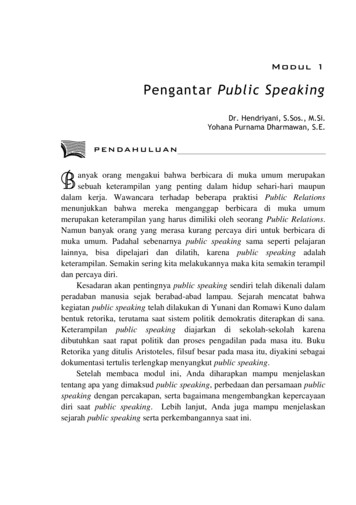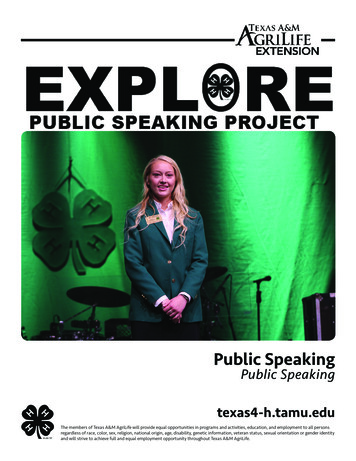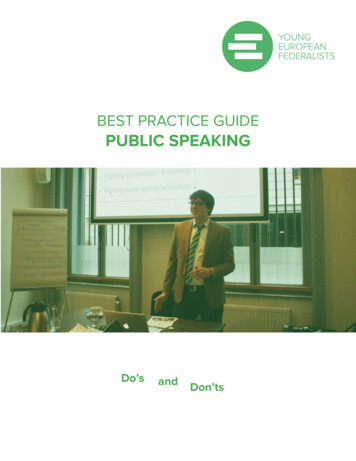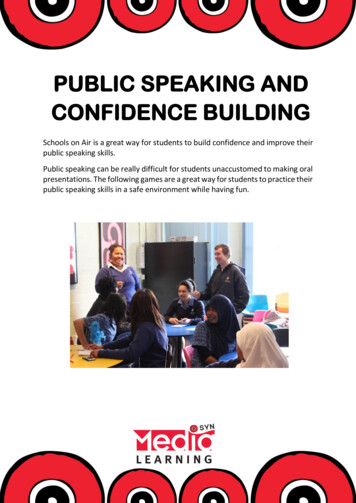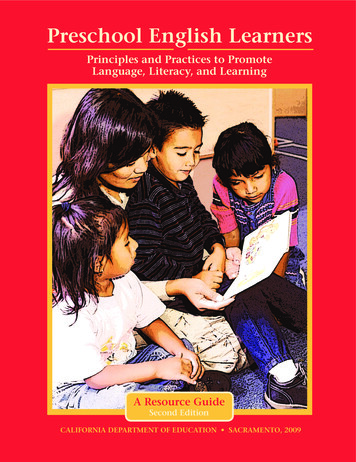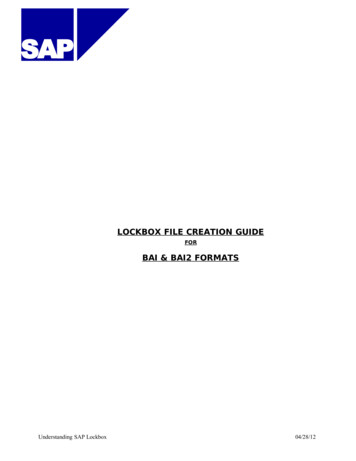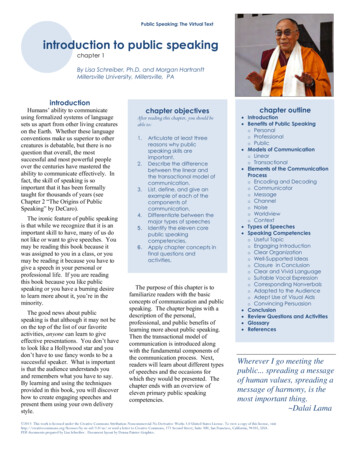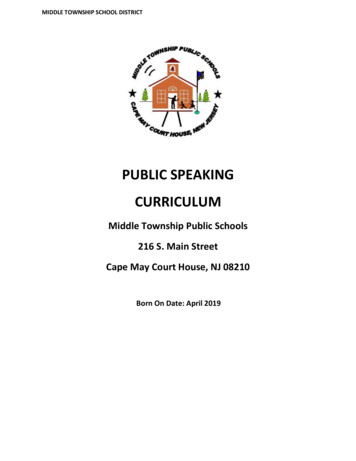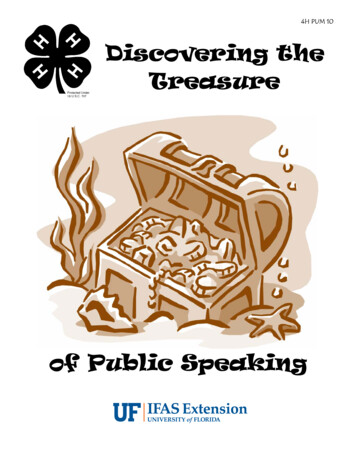
Transcription
4H PUM 10Discovering theTreasureof Public Speaking
Member Project GuideThis guide is to help you become the best public speaker you can!Learning to speak in publicis a treasure hunting experience that allows you to discover your ability as a public speaker.Activities are arranged to help you learn how to write and give a speech from beginning to end.This project has no time limit. When you feel you have mastered an area, it is time to move onto the next section. After you have completed this project book, you will be able to move on toUnit 2 in the public speaking series.Chose a project helper to support you. Your helper can be 4-H leader, a parent or other olderindividual that will meet with you and help you when needed. Write the name of your helperbelow.My ProjectHelper:Phone:Helper’s Notes for Unit 1Public Speaking Unit I is aimed at helping beginners to speak publicly - primarily 9 to 12year olds. This can vary with the member’sexperience and competence in public speaking.Unit I is focused on the development andhow-to of giving a speech. Beginning speechescan vary in length, but a standard is 3 to 5minutes.This project has no time limit. The goal is tohave members confidently give speeches bydoing research, practicing, and preparing. Thisproject can be repeated many times. It hasbeen developed to help members gain anunderstanding of research, speech writing,and public speaking.When the member feels they are comfortableto move on to the next level, Public SpeakingUnit II may be explored.24-H Public SpeakingEvents and Contests.Once the 4-H’er has mastered the basics ofpublic speaking, they can participate in thechallenge of competing in many other 4Hevents and contests for additional recognition.Check your local 4-H Extension Office fordetails.
TreasureHunting GuideYou are now ready to begin your discovery of the treasure inside of you - a great publicspeaker! Look for the picture of the treasure chest for the start of a new chapter.This means you will experience new activities as your journey continues in search ofpublic speaking skills.Chapter 1 - Uncovering Clues - Researchingand Selecting a Topic This chapter is designed to help you become familiar with different sources ofinformation, learn the difference between fact and fiction, and help you select atopic.Chapter 2 - Types of Loot - Typesof Speeches - In this chapter, youwill learn different types of speeches and where the different types of speecheswould be used.Chapter 3 - Reading a Treasure Map - WritingYour Speech - Thischapter helps you to become familiar with the parts of a speech, how to organizea speech, and methods to help you write a speech.Chapter 4 - Finding the Treasure - DeliveringYour Speech - You willhave the opportunity to prepare, practice, and deliver a speech of your own. Experience the thrill of giving your first speech!Chapter 5 - Determining Value - Critiquing- In this chapter, you willhave the opportunity to critique others, critique yourself, and learn to use a competitive scorecard.Chapter 6 - Becoming a Treasure Hunter - Careers- Many careersinvolve public speaking. You will discover a few that involve this skill and howpublic speaking relates to their job.3
. . . And Away We Go!!Record your project goals and activities in the guide. Workwith your project helper as you complete each activity.Year:My ProjectProject PlanningInterest Areasand ActivitiesDateCompletedHelperInitialsChapter 1: Uncovering Clues1. Current Events2. JournalsComplete the activities in eachsection.Chapter 2: Types of Loot1. Records2. About Yourself3. Show and TellChapter 3: Reading aTreasure Map1. Three Times2a. You are Here2b. X Marks the Spot3. Identification4. ScramblePractice and develop the lifeskills learning to learn, decisionmaking, problem solving, criticalthinking, goal setting, planningand organizing, wise use ofresources, keeping records,communication, social skills,leadership, and self-motivation.Chapter 4: Finding the Treasure1. Preparation2. Practice3. DeliveryChapter 5: Determining theValue1. Others2. Yourself3. You Be the JudgeChapter 6: Becoming aTreasure Hunter1. Identification4Project GuidelinesIncrease your knowledge aboutpublic speaking and improveyour skills needed to be a publicspeaker.Evaluate project experienceswith your helper/leader.
Chapter 1:Uncovering CluesThe first step to any activity, whether itYou uncover clues to help yoube treasure hunting or public speaking, is tolearn your material. Uncovering clues is thebeginning of a treasure hunt. You mustfirst learn where the treasure is, who put itthere, and why it is there in the first place.This is the same with public speaking.topic and what key points to make. Researching your topic allows you to be atreasure hunter. You are hunting for cluesthat will lead you to become a treasure of apublic speaker. This is the basis of all public speaking and often takes the most time.determine aCurrent EventsBefore you begin working on a speech, you must have anidea of what you want to speak about. A good way to decideis to look at current events that are happening around youand find something that interests you.To Do1extrt on the nahcehtiaFromms of medroflarevt searepage, selecevent youtnerruct heto find ae name ofhtinlilFin.,interestedTV station,emaneingaztmedia (mathe currenetadehtion),mainradio stated and thesaleersaevent wnt.urrent evecehtfotopic5
Type of Media Name of MediaDate ofReleaseTitle and Main )Now that you have several current events you are interested in, choose one to tell your4-H club about. Fill in the areas below to help you decide what to talk about.Title of Current Event:Where you found it and when it was released:Main Topic:Point #1:Point #2:Point # 3:What does this all mean:Why does it interest you?:6Did YouKnow?Main Topic - the ideaspeech,that thor artice story,le is based on.Supporting Detail - infhelps toormatioexplain/n thatrelate the topic.
Continue following the development of your current event. If more information is releasedabout it, list below when it was released, where it was released, and any new main topics aboutyour current event.Current Event:Name ofMediaDate ofReleaseTell me what youthink, Matey! Tellme what you think!Main TopicSupporting DetailsHow did you decide which topic to talk about?Which type of media provided the most information for you?Which type of media was the hardest to understand?Why is it good to look at several types of information when researching a speech?Now, show mewhat you did, Matey,Show me whatyou did!Did the current events provide a main topic and supportingdetails? Why is this important? Do you need to do this when youspeak?Talk about how you felt telling your 4-H club about your current event.How does knowing about current events help you when researchinginformation for a speech?7
One Eyed Jack’s Journals2Treasure hunting can be very dangerous.By uncovering clues, you can stayalert to who else is looking for treasure, what the weather is before yousail, and what kind of treasure it is. This is the same with public speaking.In public speaking, it is best to have the most current, up-to-date information you can get.Ships Log - April 2To Doady to goPetey is getting rer treasuretreasure hunting foher hid 75 yearshis great-grandfatn.know where to begiago. Petey doesn’teat-grandfatherPetey has found grurnals withOne-Eyed Jack’s jolp Petey on hisentries that will heurney.treasure hunting joShip’s Log - May 20We came across the treasure we had beenlooking for. We’ve been following it’s trailfor over a month. Theproblem is that we werefollowed here by pirates, so were not goingto be able to move thetreasure off the island.The island is not inhabited. It is just a small,jungle island. It’s surrounded by several othersmall islands, but this one is distinctive becauseit has a bay. We’re goingto hide it and comeback for it later whenthe coast is clear.Jack8Today, my ship sailed south. We are looking for treasure and have decided the bestplace to look would be on an island. Beforewe left Florida we cleaned the ship fromtop to bottom. We can’t start a journeywith a dirty ship. My crew is in good spritsabout this journey. We are all feelinglucky.Ship’s Log - May 16We came across the treasure we had beenlooking for. We’ve been following it’s trailfor over a month. Theproblem is that we werefollowed here by pirates, so were not goingto be able to move thetreasure off the island.The island is not inhabited. It is just a small,jungle island. It’s surrounded by several othersmall islands, but this one is distinctive becauseit has a bay. We’re goingto hide it and comeback for it later whenthe coast is clear.JackShip’s Log - July 30We finally made it home. We had somemore trouble with the pirates on the way.It’ll be a long while before we get to goback for the treasure. It should be safe untilwe get back.Jack
Things have changed a lot in 75 years and Petey also needs to have current information aboutwhere he’s going and how he is going to get there. Help Petey decide where to look for thetreasure by uncovering clues in the journal and other information sources such as encyclopedias, web pages, newspapers, and others.The Daily News, 1949Tuesday, December 14ON ISLANDWATERFALL DISCOVERED terfall ever found in thewaThe largestabitednd on a remote, uninhFlorida Keys was fou waterfall described as theisland yesterday. Ther seen, is located onmost breathtaking eve can’t ever be seen on aisland 424. Island 424map it’s so small. discoverers weren’t the firstIt’s obvious thepirate ship were foundthere. Remains of a tools were found near thealong the beach andwaterfall.9
Record the clues you have identified from the sources and put the clues together to helpPetey locate the treasure.Are Petey’s clues FACT or OPINION? Mark the boxes for each clue.ONE-EYED JACK’S JOURNALSClue 1FactOROpinionClue 2Clue 3ONE-EYED JACK’S JOURNALSClue 1Clue 2Clue 3ONE-EYED JACK’S JOURNALSClue 1Clue 2Clue 3Fact vs. Opinion10When researching, it is also importantto know the difference between FACTand OPINION. Fact is informationthat has been proven as true. Opinionis information that someone believesas truth, but may not have beenproven. You have to be careful withinformation that is opinion because itmay not always be true. Before usingany information that is opinion, youshould back it up by looking in anothersource that would only contain facts.
Tell me what youthink, Matey! Tellme what you think!Why is it important to know the difference between fact and opinion?Will your research help Petey decidewhere to begin his treasure hunting?Now, show mewhat you did, Matey,Show me whatWhy is research important in public speaking?you did!Did you have enough information to help Petey?Where else would you look for information?Danger!Do’s and Don’ts of Public SpeakingKnow the difference between fact and opinion.Use several sources when researching.Be careful when using someone’s opinion in a speech. Be sureto back it up with a fact.Sailing on. . .Use more sources in your next speech.Interview someone for a personal account ofan experience. But, make sure you know thedifference between fact and opinion.11
Chapter 2:Types of LootLoot, or treasure, is what treasure hunting isall about. When treasure hunting, you need toknow what types of loot there are. This helpsin the hunting and finding of the loot.Speeches are a lot like loot. They are the finished product of all your hard work.As you begin public speaking, it is importantto know the different types of speeches.Different speeches are used for differentsettings and occasions. With loot, there aremany different types including gold and silvercoins, diamonds, rubies, emeralds, pearls, andmany others. There are several forms of public speaking, but they differ in how they areused and what information they provide topeople.We will focus on prepared, project/personal,and demonstrations in this unit, specificallythe prepared speech. In Unit 2, you will learnto perform impromptu speeches. Introductions, inspirational thoughts, and reports areother forms of public speaking which you maybe asked to do from time to time. Definitionsare listed in the glossary in the back.Types of trationsImpromptuIntroductionReports12
Record KeepingTo keep track of what kinds of “loot” you discover, treasure huntersneed to keep records, so that everything is well documented. This isthe same with speeches. You will need to keep records of what typeof speeches you have done or will do. This way you can make sure youexplore all areas of public speaking.To DoNow that you know the differenttypes of speeches, record below whatyou have done in the past. List whattype of speech it was, when you did it,the title or theme of the speech, and whoit was given to. At the end of this unit,there is a record sheet that will allow youto record all of the speeches that you doin this project. This sheet is just to allowyou to identify what you have done inthe past.1Record of Past Public SpeakingType of SpeechDateTitleAudience/Location13
Now, see how many of each type of speeches you can identify. These speeches can be given byanyone else, just not yourself. A mayor giving a speech on Veterans Day might be an exampleof a prepared speech. See how many you can identify.Project/Personal ht for the DayPreparedReportsIntroductionOtherTell me what youthink, Matey! Tellme what you think!Was it easy identifying the different types of speeches?Which was harder to identify - a speech you had given or aspeech someone else gave?Write down how you learned to identify speeches.Now, show mewhat you did, Matey,Show me whatyou did!Describe differences you saw between the various types ofspeeches.14
About YourselfOne of the best ways to get started with public speaking is by doinga speech on something you are familiar with. What is the thing youare most familiar with? Yourself! A speech about yourself or something you are involved in, such as a 4-H project, will help you to beginpublic speaking. This type of speech can be classified as a project/personal speech and will help you on your way to becoming a greatpublic speaker!To DoBegin your speech by introducingyourself and telling a few facts aboutyourself such as how old you are, whereyou are from, and what 4-H club you arein. You can then tell the audience what youare going to speak about and why it isimportant to you. Remember to elaborateon your topic so everyone understands whatyou are speaking about.Tell me what youthink, Matey! Tellme what you think!2Ideas forProject/PersonalSpeechesWhat 4-H Means to MeWhy I Belong to 4-HThis Week in School.My Pet and IMy FamilyWas it easy to talk about yourself?Do you think it would be easier to talk about somethingother than yourself? If so, what?Now, show mewhat you did, Matey,Show me whatyou did!Write down why you think being able to do a speech aboutyourself is important.15
Show and TellOne type of speech is an illustrated talk or demonstration.This is a very common type of speech for 4-Hers. It usuallyconsists of showing or telling someone how to do something.It often has props or visual aids that help to show what youare trying to explain.To Do: ProjectDemonstration orIllustrated Talkt you haveThink about a projecgare currently workinrecently finished orinteresting thingson. Pick out severaliConcentrate on activabout this project.u can show someoneties that you know yoare going to be theelse how to do. YouH club members orteacher and your 4the students.classroom will beDemonstrationIdeasHow to Groom a Show CalfSewing on a ButtonMaking BrowniesPotting a PlantHow to Make the Best Use of Visual AidsStand beside your visual aid - not betweenit and the audience.Display visuals when needed, remove orcover it when not.Talk to the audience - not the visual aid.Be sure that a visual is readable, simple,uncluttered. Busy visuals are distracting.Size is important - check to see visibilityin relation to room size.Point out key points to your audience asappropriate. Use the arm that is closer tothe visual aid.16
Was it easier to do a speech with visual aids?Tell me what youthink, Matey! Tellme what you think!Did they help you to stay on track with what you werespeaking about?How do demonstrations differ from a speechabout yourself?Now, show mewhat you did, Matey,Show me whatyou did!List ways in which you might use demonstrations in thefuture.What things did you like/not like about giving a demonstration?Danger!Do’s and Don’ts of Public SpeakingDon’t overdo your introduction and conclusion. Leave all thedetails for the body of the speech.Do use different types of speeches for different settings.Use the appropriate type of speech in each setting.Sailing on. . .Try giving several different types of speeches. Identify theones that you need to work on more and focus on those.Identify a type of speech you’ve never done before and prepareto do one at a club meeting, other event, or just before yourfamily and friends!17
Chapter 3:Reading a Treasure MapReading a treasure map is like reading one oftoday’s road maps. First, you must figure outwhere you are. Then you must figure out howto get from where you are to your destination.Writing a speech is similar to reading a roadmap. First, you must decide which topic youwant to speak about. The introduction allowsyou to tell what you are speaking on and whatyour speech is going to be about. It starts thebeginning of your trip.Then, you must figure out what you want tosay in your speech. The body is the trail youfollow that allows you to get from where youare to where you want to go - the treasure.The final portion is where the treasure is the conclusion. This is the wrap-up of thespeech. It restates your main points of yourspeech and says anything else you want to say.Check out the glossary for a more completedefinition.Did You Know .Introduction - Introduces the topic that you willspeak on and gathers the audience’s interest.Body - Contains all supporting details and factsabout your topic.Conclusion - Summarize your main points and restate the purpose of the speech.Outline - Outlines are formats that help you organize your thoughts into a speech.18
Three Times,Three Times,Three TimesOutlines help you to see what you need to talk about.An outline1gives you something to follow and makes it easier to organize yourspeech. The “three times” format is just one way to outline a speech.There are others, but we will only focus on this one.Speeches can be set up in a “THREETIMES” FORMAT. The Main Ideasare stated in the introduction.The INTRODUCTION is the beginningof your speech. It tells your audiencewhat you will talk about by giving them abrief overview. This is where you willcapture the interest of the audience.In the BODY of the speech, you again restate each of your main points andexpand on them. This is the “meat” of your speech. All of the information youwant to get to the audience is given here. With each main point, you will giveseveral Supporting Details.Finally, the CONCLUSION is given. This is the summary of the speech and isa chance to say any final things about your topic. Again, you restate your mainpoints, but do not go into detail. The conclusion is the wrap-up and should endvery concisely.The “Three times” format allows you to tell what you’re going to say, say it, andtell what you just said. Audience members then have an idea of what your speechis about and it keeps their attention.19
To Do1. Read Petey’s speech on the following page abouthis adventures to help you identify parts of thespeech. Notice how Petey states everything in theintroduction, talks about it in the body, and states it againin the conclusion.2. After you have read Petey’s speech, compare it to theoutline on the next page that Petey did before he wrote thespeech.3. Now that you know how to prepare a speech outline and how ithelps you to write a speech, you can outline a speech of your own.On page 21 is an outline format to help you. Remember to say it“three times”. Outline what you are going to say in yourintroduction, tell about it in the body, and conclude by tellingwhat you just talked about.4. After you have your speech outlined, go ahead and reviewyour outline speech with your 4H Club Leader/Helper.Ideas for OutlinesProjectsPhotography: Focusing Your CameraNutrition for SwineHelping Around the HouseBabysittingPersonalAbout your schoolFamily4-HAbout your club20
Petey’s AdventureI have had many adventures while I have been treasure hunting(Introductory Sentence). I have been shipwrecked (Main point #1),been caught in a storm (Main point #2), and had my treasure stolenby pirates (Main point #3).My first (Transition) adventure happened when I first startedtreasure hunting. I was part of a crew of a ship that was sailing at sea. All of a sudden,the ship hit a rock and caused it to wreck (Main Point #1). Everybody had to jump overboard and swim to an island (Supporting detail). Luckily, no one was hurt. We did haveto build a new ship before we could continue on our journey (Supporting detail).My next (Transition) adventure happened when I was again at sea. I was captainof a ship when we got caught in the biggest storm I have ever seen (Main Point #2). Thestorm caused the sea to have really rough waves and we couldn’t steer the ship(Supporting detail). We got blown off of our course (Supporting detail). It took us anextra month to get home because of the storm (Supporting detail).My latest (Transition) adventure had to do with pirates (Main Point #3). Wewere on an island looking for treasure, but all we had found was a couple of old bottlesand chests (Supporting detail). We hadn’t found any loot (Supporting detail) . Piratescame and stole all of our treasure (Supporting detail). They just didn’t realize what wehad as treasure was really just junk (Supporting detail).I have many adventures while I am treasure hunting. (Conclusion sentence) Ijust gave you an idea of a few of my adventures like shipwrecks (Main point #1), storms(Main point #2), and pirates (Main point #3).21
Example Outline: Petey’s Adventure“Three Times” FormatIntroduction Petey’s AdventureMain Point #1 - shipwreckMain Point #2 - stormMain Point #3 - piratesSupporting Detail - were at sea and the ship hit a rockBody Main Point #1 - shipwreckSupporting Detail - everybody fell overboard and swamto an islandSupporting Detail - everybody was safe, but we had tobuild a new shipBody Main Point #2 - stormSupporting Detail - again, we were at sea when a bigstorm cameSupporting Detail - it was really windy and we got blownoff courseSupporting Detail - it took us an extra month to get homeSupporting Detail - we were on an island looking fortreasureBody Main Point #3 - piratesSupporting Detail - we found a couple of old bottles andchests, but no lootSupporting Detail - pirates came and stole it from us,but they never realized there wasn’t any lootConclusion Petey’s AdventuresMain Point #1 - shipwreckMain Point #2 - stormMain Point #3 - pirates22
Your Outline“Three Times” FormatMain Point #1 IntroductionMain Point #2 Main Point #3 Supporting Detail -BodyMain Point #1Supporting Detail Supporting Detail Supporting Detail -BodyMain Point #2Supporting Detail Supporting Detail Supporting Detail -BodyMain Point #3Supporting Detail Supporting Detail Main Point #1 -ConclusionMain Point #2 Main Point #3 -23
Tell me what youthink, Matey! Tellme what you think!How did the outline help you in setting up your speech?Do you think you will continue using the outline to help you writespeeches?Do knowing the parts of a speech help you to write one?Did the outline help you to stay on track when you gave your speech?How will outlines help you in writing future speeches?Now, show mewhat you did, Matey,Show me whatyou did!Show me why you think it is a good idea for speeches to beseparated into parts.24
Part A: You Are Here!!When writing speeches, you must begin at a certain spot the introduction. This sets up your whole speech and allowsyour audience to know what you are talking about.2To DoPetey is having trouble beginning his speech. Thebody of the speech is written on the next page.Help Petey out by writing an introduction for Petey’sstory. Don’t forget to use attention grabbers to helpgain the audience’s attention. Also use the“three times” format to help you set up theintroduction.Use the space below to write down points Petey has made in the story. If you need help,use the “three times” format to help you.25
Petey’s StoryIntroduction (write one here)The first time I was on a ship I was a cabin boy. The cabin boy is responsible for thecleanliness of the ship and is also a helper to the captain. As the cabin boy, I spent a lot oftime scrubbing the deck to make sure it was sparkling clean. I also spent a lot of time withthe captain bringing him his food, making his bed, and doing any little chores he needed me todo. I enjoyed being a cabin boy because I got to be on a ship.I stayed a cabin boy for awhile, but soon I was promoted to a ship hand. This meant Igot to help sail the ship. I was in charge of keeping the sails in good working order and making sure we were getting plenty of wind. I also got to work with other ship hands on repairsfor the ship.I now have been sailing for many years and this last time I went to sea I finally got tobe my own ship’s captain. This is probably the hardest job because I spend most of my timemaking sure everyone else is doing their job. I also am in charge of all the ship’s records.The hardest part of my job now is making sure I know where we are going at all times. I amin charge of plotting courses for my men to sail.26
Part B: X Marks the SpotWhen writing speeches, you must begin at a certain spot the introduction. This sets up your whole speech and allowsyour audience to know what you are talking about.To DoNow that you havewrittenan introduction for Petey’sstory, he now needsaconclusion. Usingthe story fromPart 1, write a conclusion below.Petey’s Story (continued)Conclusion (write one here)27
Tell me what youthink, Matey! Tellme what you think!Did you find writing an introduction and conclusionto Petey’s story hard?What did you like/not like about writing an introduction andconclusion to someone else’s story?How are introductions and conclusions important tospeeches?What was the main idea of Petey’s story?28Now, show mewhat you did, Matey,Show me whatyou did!
Identify the PartsAn important part of public speaking is being able toidentify the parts of a speech and what makes up thoseparts. We have already covered what the introduction,body, and conclusion are. These make up the entirespeech. Within each part, there can be main points,introductory sentences, supporting details, and transitions.Definitions for these can be found in the glossary.3To DoPetey has just given a speech about coconuts. Hehas to fill out the form below, but he doesn’t knowhow. Help Petey out by identifying the parts andwriting them in the blanks. Several parts can be usedmore than once, and some may not be used at all.The parts have been listed for you. Petey’s speech ison the following page.IntroductionMain Point(s)Supporting ory SentenceSummarizeThe first paragraph is the . The main ideas for the speechare , , and .The last paragraph is the . It helps to allthe main points of the speech.The paragraphs in between the first and last paragraph make up the ofthe speech, or what is sometimes called the meat of the speech.The first sentence in the second paragraph is the of thisparagraph. Every other sentence in this paragraph helps to it.The third paragraph contains a in the first sentence. This helps tosmoothly move from the second paragraph to the third.29
Bert . The CocoNUT Monkey!I once knew a monkey, named Bert, who loved coconuts. Bert ate coconuts all daylong, grew them all over his island, and made his whole house out of coconuts. This monkeyreally liked coconuts.Bert ate coconuts all day long. He had coconut milk for breakfast along with hiscoconut omelet. He then had a sliced coconut sandwich for lunch and for dinner Bertwould eat fried coconut with coconut salad. He loved to eat coconuts.Besides eating coconuts, Bert also loved to grow them. He would grow them allover his island. Bert grew them all along the beach, in the jungle, and on a cliff. It was alot of work for Bert to grow them in so many places, but wherever he went on his island healways had a coconut to eat. Bert loved to eat coconuts.Because Bert ate a lot of coconuts, he had a lot of empty coconut shells layingaround. One day, he decided it was getting to messy and he needed to do something withhis coconut shells. He decided to build a house. The floorwas made of coconuts shells, the walls were made of coconutshells, and the roof was made of coconut shells. Bert stillloves to eat coconuts, so now he’s started making furnitureout of the coconut shells.Bert loves to eat coconuts. Because he loves to eatcoconuts all day long, he has to grow them all over his island.This means he has a lot of empty coconut shells, so he built ahouse out of all of the empty coconut shells. Bert, themonkey, loves to eat coconuts.30
Tell me what youthink, Matey! Tellme what you think!How does knowing the parts of a speech help you when giving orwriting a speech?Was it hard identifying the parts of a speech? Do you think it would geteasier with practice?Being able to identify the parts of the speech is importantbecause .Now, show mewhat you did, Matey,Show me whatyou did!Knowing the parts of the speech helps me to .31 pag
Public Speaking Unit I is aimed at helping be-ginners to speak publicly - primarily 9 to 12 year olds. This can vary with the member’s experience and competence in public speaking. Unit I is focused on the development and how-to of giving a speech. Beginning speec
